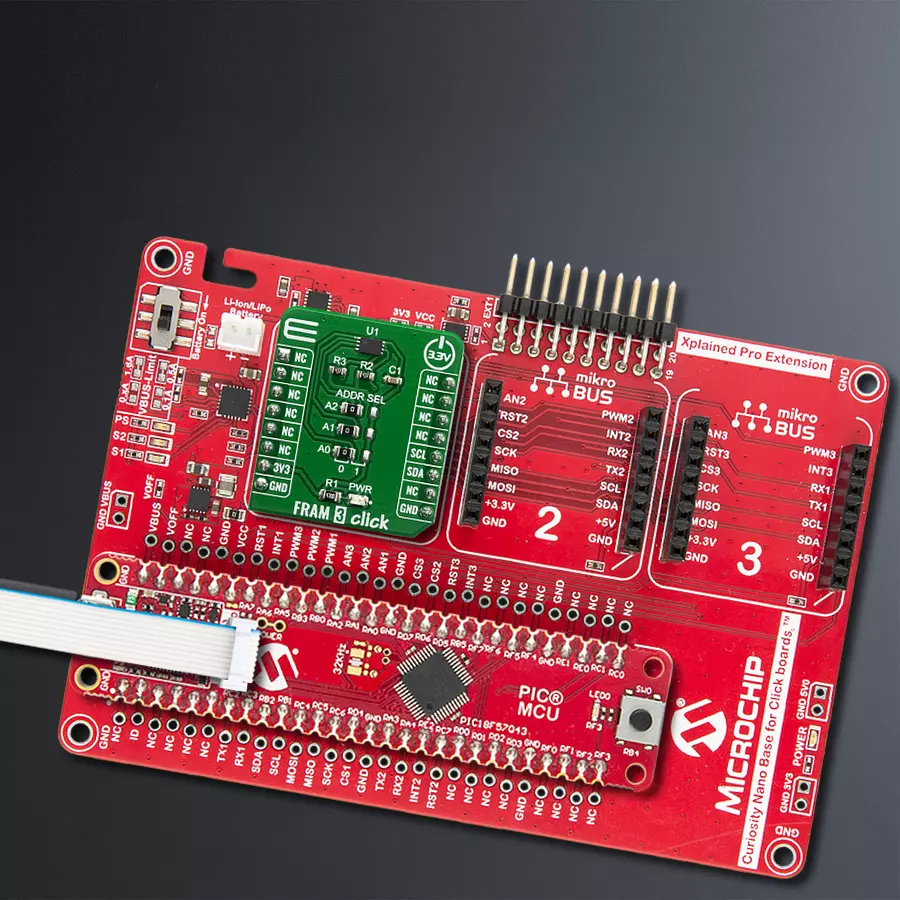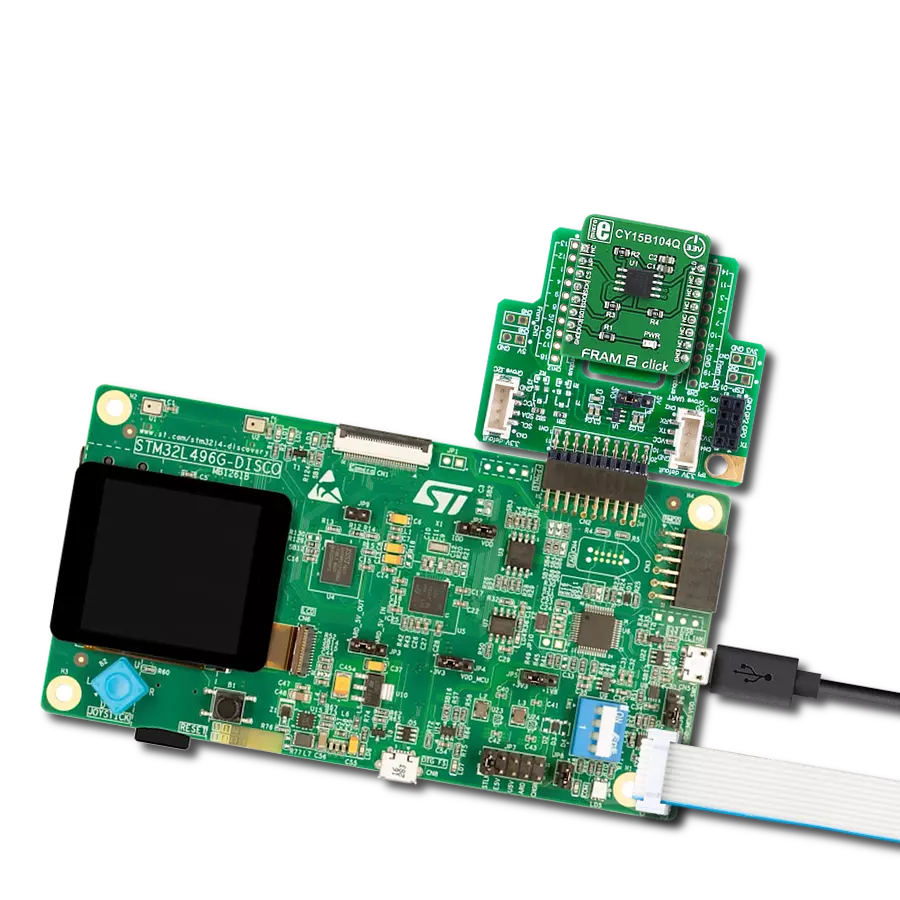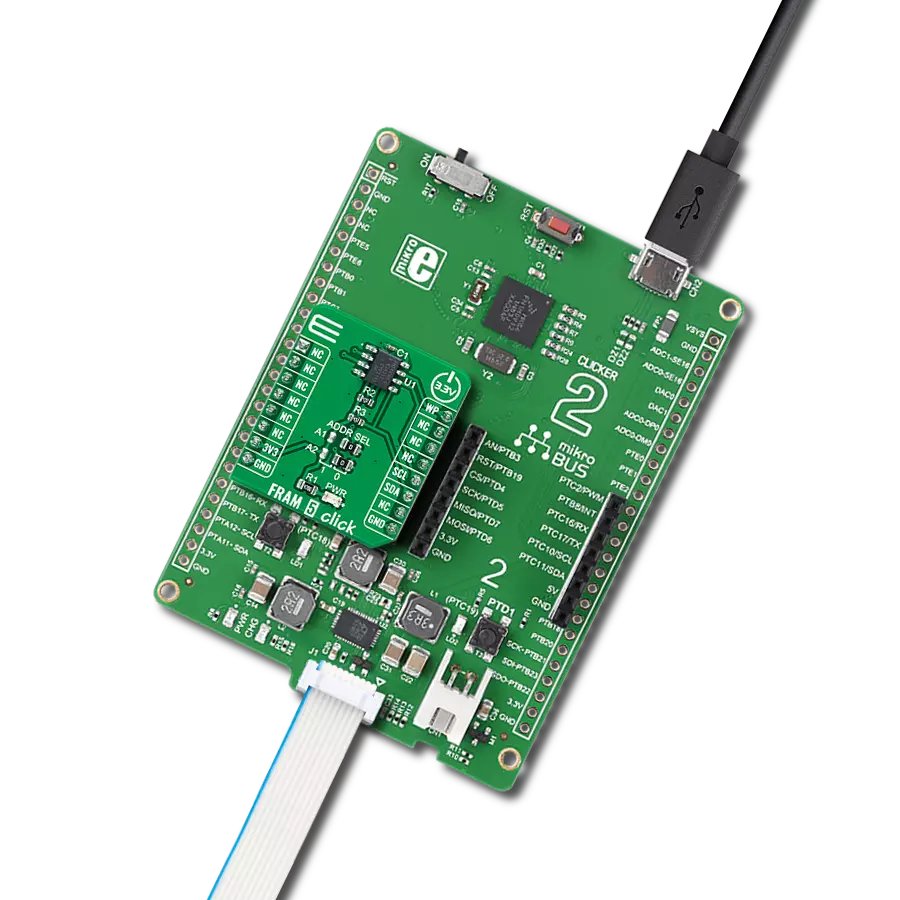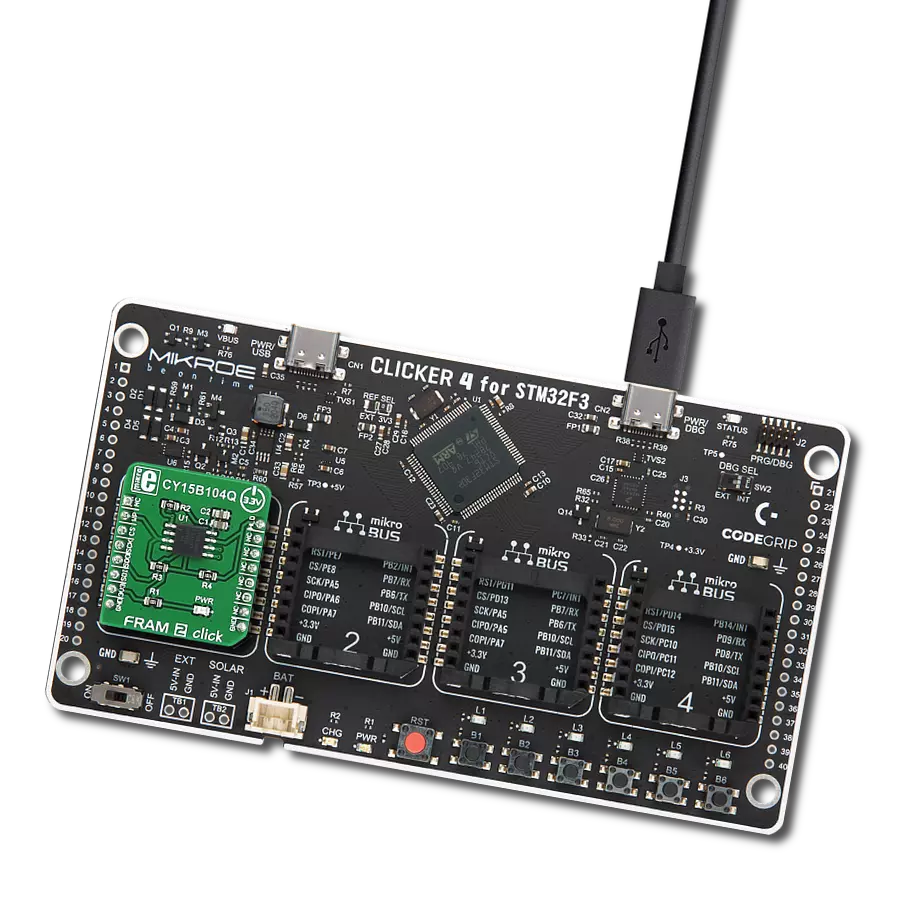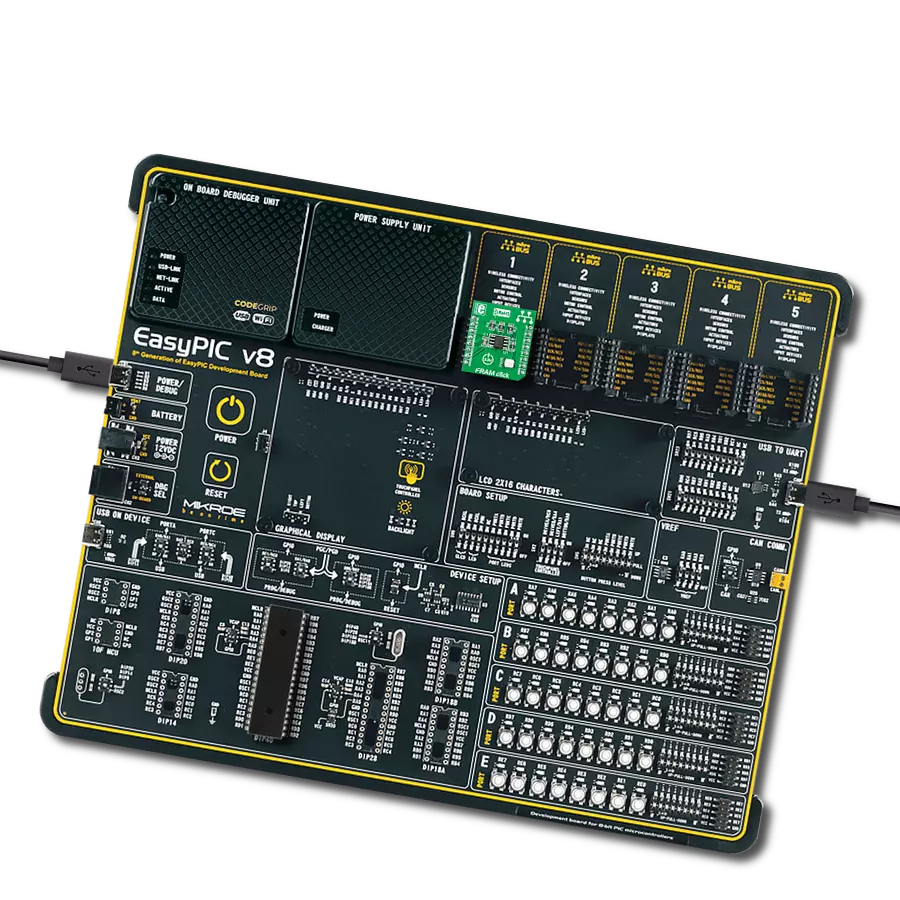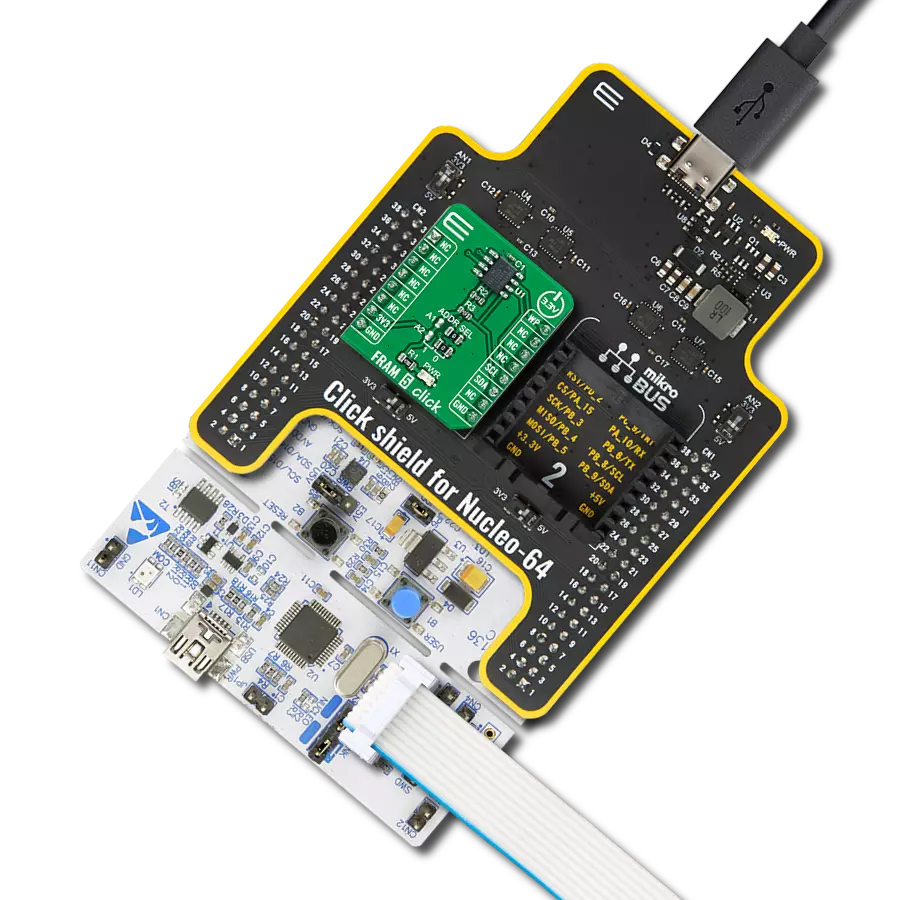Upgrade your design with FRAM memory for unmatched performance and endurance
A
A
Hardware Overview
How does it work?
FRAM 3 Click is based on the MB94R330, a FRAM (Ferroelectric Random Access Memory) authentication IC from Fujitsu Semiconductor, made using ferroelectric and silicon gate CMOS process technologies to form nonvolatile memory cells. The MB94R330 adopts an original communication protocol based on the two-wire serial interface (I2C BUS), a hardware cryptographic macro, and a proprietary control core. It is suitable for detecting cloned peripherals and accessories used in electric equipment such as printers and multifunction printers. Ferroelectric technology is still being developed and perfected, but the advantages have already been demonstrated. This technology exploits the properties of ferroelectric materials to retain the electric field after exposure, the same way the ferromagnetic materials retain their magnetic field. This phenomenon is employed to polarize the FRAM cells and store the information.
One area that still needs improvement is the thermal instability, especially at high temperatures. When the ferroelectric material reaches the Curie temperature, its properties are degraded. Therefore, the high temperature might damage the content of the FRAM module. This is illustrated by the data retention period: while working at 55˚C, the data retention period is ten years. Still, combined with the endurance of 1010 read/write cycles at bus write speed, this type of memory still represents an ideal solution for applications with frequent writing to nonvolatile memory locations. This Click board™ uses the I2C communication protocol, allowing fast serial clock rates. The device employs certain protection mechanisms to ensure reliable data transactions and avoid accidental writing to the memory array. The MB94R330 supports the I2C bus and operates as a peripheral device. The role of the communication for the I2C bus is different from
the "Master" side and the "Slave" side. The master side has the authority to initiate control. Furthermore, the party line can be connected, which connects two or more peripheral devices to one master. In this case, the slave side has a unique address, respectively, and after specifying the address on the slave side, the master side starts to communicate. The FRAM 3 click is suitable for detecting cloned peripherals and accessories used in electric equipment such as printers, multifunction printers, and more. This Click board™ can be operated only with a 3.3V logic voltage level. The board must perform appropriate logic voltage level conversion before using MCUs with different logic levels. Also, it comes equipped with a library containing functions and an example code that can be used as a reference for further development.
Features overview
Development board
PIC18F57Q43 Curiosity Nano evaluation kit is a cutting-edge hardware platform designed to evaluate microcontrollers within the PIC18-Q43 family. Central to its design is the inclusion of the powerful PIC18F57Q43 microcontroller (MCU), offering advanced functionalities and robust performance. Key features of this evaluation kit include a yellow user LED and a responsive
mechanical user switch, providing seamless interaction and testing. The provision for a 32.768kHz crystal footprint ensures precision timing capabilities. With an onboard debugger boasting a green power and status LED, programming and debugging become intuitive and efficient. Further enhancing its utility is the Virtual serial port (CDC) and a debug GPIO channel (DGI
GPIO), offering extensive connectivity options. Powered via USB, this kit boasts an adjustable target voltage feature facilitated by the MIC5353 LDO regulator, ensuring stable operation with an output voltage ranging from 1.8V to 5.1V, with a maximum output current of 500mA, subject to ambient temperature and voltage constraints.
Microcontroller Overview
MCU Card / MCU

Architecture
PIC
MCU Memory (KB)
128
Silicon Vendor
Microchip
Pin count
48
RAM (Bytes)
8196
You complete me!
Accessories
Curiosity Nano Base for Click boards is a versatile hardware extension platform created to streamline the integration between Curiosity Nano kits and extension boards, tailored explicitly for the mikroBUS™-standardized Click boards and Xplained Pro extension boards. This innovative base board (shield) offers seamless connectivity and expansion possibilities, simplifying experimentation and development. Key features include USB power compatibility from the Curiosity Nano kit, alongside an alternative external power input option for enhanced flexibility. The onboard Li-Ion/LiPo charger and management circuit ensure smooth operation for battery-powered applications, simplifying usage and management. Moreover, the base incorporates a fixed 3.3V PSU dedicated to target and mikroBUS™ power rails, alongside a fixed 5.0V boost converter catering to 5V power rails of mikroBUS™ sockets, providing stable power delivery for various connected devices.
Used MCU Pins
mikroBUS™ mapper
Take a closer look
Click board™ Schematic

Step by step
Project assembly
Software Support
Library Description
This library contains API for FRAM 3 Click driver.
Key functions:
fram3_read_free_access_memory- Memory read functionfram3_write_free_access_memory- Memory write function
Open Source
Code example
The complete application code and a ready-to-use project are available through the NECTO Studio Package Manager for direct installation in the NECTO Studio. The application code can also be found on the MIKROE GitHub account.
/*!
* \file
* \brief FRAM3 Click example
*
* # Description
* This application writes data in memmory and reads data from memmory.
*
* The demo application is composed of two sections :
*
* ## Application Init
* Initializes device init
*
* ## Application Task
* Writes and then reads data from memory
*
* \author MikroE Team
*
*/
// ------------------------------------------------------------------- INCLUDES
#include "board.h"
#include "log.h"
#include "fram3.h"
// ------------------------------------------------------------------ VARIABLES
static fram3_t fram3;
static log_t logger;
static char write_data[ 7 ] = { 'M', 'i', 'k', 'r', 'o', 'E', 0 };
// ------------------------------------------------------ APPLICATION FUNCTIONS
void application_init ( void )
{
log_cfg_t log_cfg;
fram3_cfg_t cfg;
/**
* Logger initialization.
* Default baud rate: 115200
* Default log level: LOG_LEVEL_DEBUG
* @note If USB_UART_RX and USB_UART_TX
* are defined as HAL_PIN_NC, you will
* need to define them manually for log to work.
* See @b LOG_MAP_USB_UART macro definition for detailed explanation.
*/
LOG_MAP_USB_UART( log_cfg );
log_init( &logger, &log_cfg );
log_info( &logger, "---- Application Init ----" );
// Click initialization.
fram3_cfg_setup( &cfg );
FRAM3_MAP_MIKROBUS( cfg, MIKROBUS_1 );
fram3_init( &fram3, &cfg );
}
void application_task ( )
{
char read_data[ 7 ];
uint8_t cnt;
uint8_t status_check;
log_printf( &logger, " - Writing... \r\n" );
Delay_ms ( 500 );
status_check = fram3_write_free_access_memory( &fram3, 0x00, &write_data[ 0 ], 7 );
if ( status_check == FRAM3_ERROR )
{
log_printf( &logger, " - ERROR WRITING!!! \r\n" );
for ( ; ; );
}
log_printf( &logger, " - Reading... \r\n" );
Delay_ms ( 500 );
status_check = fram3_read_free_access_memory( &fram3, 0x00, &read_data[ 0 ], 7 );
if ( status_check == FRAM3_ERROR )
{
log_printf( &logger, " - ERROR READING!!! \r\n" );
for ( ; ; );
}
for ( cnt = 0; cnt < 7; cnt++ )
{
log_printf( &logger, " %c ", read_data[ cnt ] );
Delay_ms ( 100 );
}
log_printf( &logger, " \r\n " );
Delay_ms ( 1000 );
log_printf( &logger, "__________________________\r\n " );
Delay_ms ( 500 );
}
int main ( void )
{
/* Do not remove this line or clock might not be set correctly. */
#ifdef PREINIT_SUPPORTED
preinit();
#endif
application_init( );
for ( ; ; )
{
application_task( );
}
return 0;
}
// ------------------------------------------------------------------------ END
Additional Support
Resources
Category:FRAM









